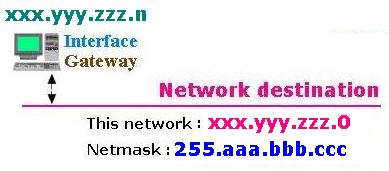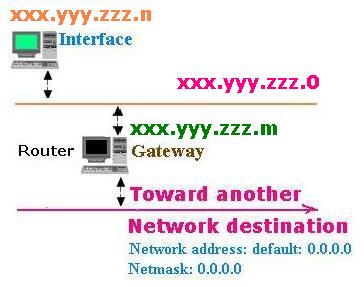2.Example:

From the ISP, we are assigned a Class B network: 200.100.x.y.
From this assigned IP-Address, we want to make 2 subnets Class C networks.
- Class C Network1: 200.100.0.0, and
- Class C Network2 and Network3: 200.100.1.0 repecively
Segment Network1:
The IP-Addresses in this subnet will range from 1 to 254.
The related mask is 0 (that is the netmask is 255.255.0.0.)
0: Reserved: This Network.
255: Reserved: Broadcast
The subnet (Network2, Network2)is divided into two sub-subnets,
which will take the same number of hosts. Then the mask is
128 (256/2 = 128) (that is the netmask is 255.255.255.128)
Segment Network2:
The IP-Addresses will range from 1 ? 126
0: Reserved: This Network.
127: Reserved: Broadcast
Segment Network3:
The IP-Addresses will range from 129 ? 254
128: Reserved: This Network.
255: Reserved: Broadcast
3. Related routing tables
The network address of the segment Network1 is 200.100.0.0. This portion is a Class C network. The addresses range from 200.100.0.1 to 200.100.0.254 (recall 200.100.1.0 and 200.100.1.255 are reserved for This-Network and Broadcast addresses respectively). The IP-Address 200.100.0.1 is given for the B-Network1 Interface. Foretheremore,
let's give 200.100.0.2 as an IP-Address for the node A
(we can assign also for the node X the address 200.100.0.3 ? 200.100.0.254).
Node A
| Network destination | Netmask | Gateway | Interface |
| 200.100.0.0 | 255.255.255.0 | 200.100.0.2 | 200.100.0.2 |
| 0.0.0.0 | 0.0.0.0 | 200.100.0.1 | 200.100.0.2 |
Let's assign to the router B the IP-Address 200.100.2.1 toward ISP; and
200.100.2.254 to the Interface for ISP towards B.
Node B
| Network destination | Netmask | Gateway | Interface |
| 200.100.0.0 | 255.255.255.0 | 200.100.0.1 | 200.100.0.1 |
| 200.100.1.0 | 255.255.255.128 | 200.100.1.1 | 200.100.1.1 |
| 200.100.2.0 | 255.255.254.0 | 200.100.2.1 | 200.100.2.1 |
| 0.0.0.0 | 0.0.0.0 | 200.100.2.254 | 200.100.2.1 |
Node C
| Network destination | Netmask | Gateway | Interface |
| 200.100.1.0 | 255.255.255.128 | 200.100.1.2 | 200.100.1.2 |
| 200.100.1.128 | 255.255.255.128 | 200.100.1.129 | 200.100.1.129 |
| 0.0.0.0 | 0.0.0.0 | 200.100.1.2 | 200.100.1.2 |
Let's assign to the node D the IP-Address 200.100.1.130
(the node Z can be assigned 200.100.1.131 ? 200.100.1.254)
Node D
| Network destination | Netmask | Gateway | Interface |
| 200.100.128 | 255.255.255.128 | 200.100.1.130 | 200.100.1.130 |
| 0.0.0.0 | 0.0.0.0 | 200.100.1.129 | 200.100.1.130 |
|


